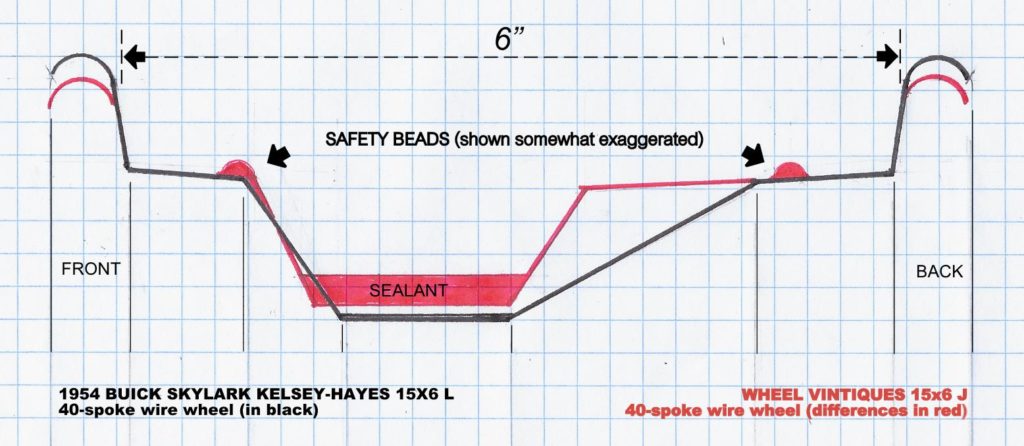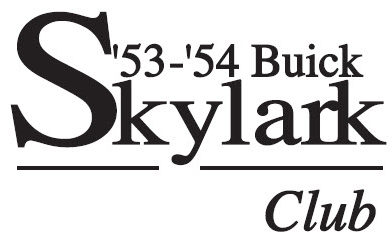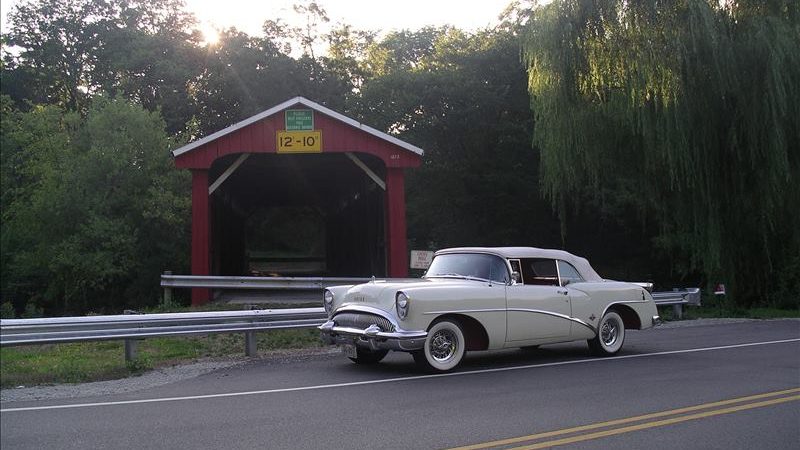500 MILES WEST OF FLINT by Al ‘Junior’ Malachowski
Are you running original Kelsey-Hayes (K-H) wire wheels on your Skylark that have exceeded their life expectancy? At least those were the words of choice Buick used when they issued a Service Bulletin to Dealer Service Departments in 1955 to remind wire wheel owners that there was no way to determine the wheel’s life expectancy due to variable driving habits and road conditions. The article went on to say that before a set of new tires are mounted, wheels should be checked for radial and lateral runout by an authorized K-H Service Station that has the specialized equipment. The article did not specifically address the numerous spoke problems you read about today: stretched, bent, broken, weakened tensile strength, or failures due to hydrogen embrittlement.
Back up a few years prior to when that Bulletin was written. Bias-ply tires that required inner tubes were the norm and tubeless tires were in the final design stages when the Skylark wire wheel was designed and built. Starting in 1955, all new Buicks came standard with tubeless tires except when you paid extra for the five wire wheels package-option and only then, inner tubes were provided with the tires according to Buick literature. Does that tell you anything? The 40-spoke K-H wire wheel option was not advertised as an available factory option on 1956 and later-year Buicks.
So you decided to send your original wheels out for new chrome and a new lease on life rather than buying a set of the Wheel Vintiques (WV) 6”-wide Skylark-style reproduction wire wheels that are advertised as allowable to run tubeless tires. You rationalized that spending a few more dollars to upgrade your OEM chrome-plated carbon steel spokes with the stronger polished stainless steel spokes and a layer of silicone sealant for air-tightness would be just as good as the WV wheels. Besides, you didn’t have to buy new inner flaps and tubes and worries about pinching, puncturing, and patching inner tubes ceased. After the new tires were mounted, you now have second thoughts whether those upgrades were enough to run your new bias-ply tubeless tires without inner tubes. Did you miss anything?
There are eight visible differences between the K-H and WV wheels that I noticed when I placed one of each wheel side by side without a mounted tire; there could be more. Two of the eight affect running tires without inner tubes: the already mentioned sealant and the obvious safety beads, both seen on the WV wheel. Safety beads are designed to provide a better tire to wheel fit, prevent tire slide on the bead seat, and prevent air pressure loss due to horizontal forces when turning corners. Without an inner tube, it doesn’t take much to pop a bead resulting in total air pressure loss within a split second and possibly control of your vehicle. Without inner tubes and safety beads, you are most likely running what is considered an illegal tire/wheel combination in your state or country. Have any doubts? I suggest you consult your insurance agent or local law enforcement agency. You don’t want to be involved or liable for a serious or fatal mishap due to running any type of tire without an inner tube on a wheel that was designed for an inner tube-type tire. I guarantee it.

My sketch above (quarter-inch grids) should give you a better idea of the rim contour comparison of the two wheels and the safety bead locations. The letter following the wheel size (J or L) denotes the rim contour designation that meets certain dimensional criteria. The cross section profile of a 1953 Skylark K-H 15×6½ L wire wheel is similar to the 1954 K-H 15×6 L wheel shown…difference being a half-inch wider drop center. Note also that the WV wheel is shorter in overall height (by 3/8”) than the K-H wheel when measured from top to bottom flange. That difference would be noticeable only if you were running one of each wheel on the same side of your Skylark with the same size whitewall tires. The exposed whitewall width would be 3/16” wider on the WV wheel than the one on the K-H wheel.
I shied away from mentioning anything about running a radial tire, with or without an inner tube, on an original K-H wire wheel…a whole new can of worms. After reading too many opinions, I am not totally convinced that 40 cross-laced spokes is the magic number. For those interested in reading about the other differences between the K-H and WV wire wheels, along with a few BCA wire wheel judging opinions and requirements of running inner tubes with wire wheels, check out the following link on the internet’s AACA/BCA General Forum Site… http://forums.aaca.org/topic/266693-wheels/. You might recognize the author of a few posts and the additional thread noted near the bottom of page two.
TOODLE-LOO!

